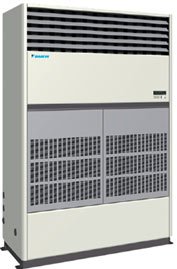A packaged air conditioner is a type of air conditioning system used for cooling and sometimes heating indoor spaces. It is called “packaged” because all the necessary components for air conditioning are contained within a single unit. This unit is typically located outside a building, either on the ground or on a rooftop.
Packaged air conditioners offer a powerful and versatile solution for cooling commercial, industrial, and even large residential spaces. These self-contained units come pre-assembled at the factory, containing all the essential components for efficient air conditioning. Let’s delve deeper into the world of packaged air conditioners, exploring their types, functionalities, benefits, drawbacks, and considerations for installation.

Here are some key features and components of a packaged air conditioner:
Compressor: This is the heart of the system. It compresses and circulates the refrigerant, which is responsible for heat exchange in the system.
Condenser Coil: This coil is responsible for releasing heat from the refrigerant to the outside air.
Evaporator Coil: This coil is responsible for absorbing heat from indoor air, cooling it down.
Air Handler: The air handler contains a blower fan that circulates air over the evaporator coil. It also contains the filter and ductwork for distributing the conditioned air throughout the building.
Refrigerant Lines: These are copper or aluminum tubes that carry the refrigerant between the indoor and outdoor units.
Thermostat: A thermostat controls the temperature by sensing the indoor temperature and signaling the system to turn on or off.
Types of Packaged Air Conditioners:
Packaged air conditioners come in two primary configurations:
Rooftop Units (RTUs): As the name suggests, these units are installed on the rooftop of a building. They are ideal for multi-story buildings and are available in various sizes and capacities to cater to different cooling needs. RTUs can be further categorized based on the condenser type:
- Air-Cooled RTUs: The most common type, utilizing fans to expel heat from the condenser coil to the outside air.
- Water-Cooled RTUs: Employ a cooling tower and water to remove heat from the condenser coil, offering better efficiency in hot and humid climates.
Split Systems: These packaged units are divided into two sections: the condenser located outdoors and the evaporator coil housed indoors. Split systems are often used in large residential settings or commercial applications where rooftop installation isn’t feasible.
Working Principle:
The core functionality of a packaged air conditioner revolves around the refrigerant cycle:
- Heat Absorption: Warm indoor air is drawn into the unit by the blower and passed over the evaporator coil.
- Evaporation: The refrigerant, a low-boiling-point liquid, absorbs heat from the warm air, causing it to evaporate. This process cools the indoor air.
- Compression: The now-evaporated, low-pressure refrigerant gas is drawn into the compressor, which pressurizes it, raising its temperature.
- Condensation: The hot, high-pressure refrigerant gas travels to the condenser coil. Here, heat is released to the outside environment (air or water, depending on the condenser type). The refrigerant condenses back into a liquid state.
- Expansion: The high-pressure liquid refrigerant passes through the expansion valve, which reduces its pressure and temperature.
- Repeat Cycle: The cooled liquid refrigerant then returns to the evaporator coil, ready to absorb more heat from the indoor air. The cycle repeats continuously, maintaining a comfortable indoor temperature.
Advantages of Packaged Air Conditioners:
- Easy Installation: Compared to central air conditioning systems, packaged units require minimal on-site assembly, streamlining the installation process.
- Flexibility: Available in a wide range of sizes and configurations, packaged air conditioners can cater to the cooling needs of various building types and layouts.
- No Ductwork Required: Rooftop units eliminate the need for extensive ductwork installation, saving costs and simplifying the process, especially in buildings lacking existing ductwork.
- Compact Design: Packaged units are self-contained and occupy a smaller footprint compared to central air conditioning systems with separate components.
- Zoning Capabilities: Some packaged air conditioners can be configured to provide zoned cooling, allowing for independent temperature control in different areas of a building.
- Durability: Built for commercial and industrial applications, packaged units are generally robust and designed for long-term operation.
Disadvantages of Packaged Air Conditioners:
Higher Initial Cost:
The upfront cost of a packaged air conditioner can be higher compared to window units or some central air conditioning systems. This includes the unit itself, installation expenses (though installation is generally simpler than central AC), and potential modifications needed for electrical service or structural support (rooftop units).
Noise:
Rooftop units, in particular, can generate significant noise pollution. This is due to the operation of the compressor, condenser fan, and airflow within the unit. The noise can be disruptive for occupants in nearby buildings or residences. Strategies to mitigate noise include:
- Sound Enclosures: Installing sound enclosures around the unit can significantly dampen noise levels.
- Proper Unit Placement: Strategically placing the unit away from noise-sensitive areas can minimize the impact.
- Lower Speed Fans: Utilizing variable-speed fans can help reduce noise during off-peak cooling hours.
Efficiency:
While packaged air conditioners can be efficient, there are some factors that can affect their overall performance:
- Ductwork Losses (Rooftop Units): Rooftop units rely on ductwork to distribute cool air throughout the building. Uninsulated or improperly sized ducts can lead to heat gain or loss, reducing efficiency.
- Air-Cooled Condenser Performance: In hot and humid climates, air-cooled RTUs might experience a decrease in efficiency. This is because the hot outside air used for condenser cooling becomes less effective in removing heat from the refrigerant. Water-cooled RTUs can offer better efficiency in such conditions.
Maintenance Considerations:
Regular maintenance is crucial for optimal performance and longevity of a packaged air conditioner. While generally reliable, these units require cleaning of filters and coils, as well as periodic professional inspections to ensure proper operation and identify potential issues early on.
Additional Disadvantages:
- Limited Zonal Control: While some packaged units offer zoned cooling capabilities, the level of control might be less precise compared to central air conditioning systems with dedicated thermostats in each zone.
- Accessibility for Maintenance: Rooftop units require safe access for maintenance personnel, which might involve additional considerations like roof hatches or walkways.
- Aesthetics: Rooftop units can be visually bulky and might not be ideal for buildings with architectural concerns.
In conclusion, packaged air conditioners offer a powerful and versatile cooling solution, but it’s essential to weigh the advantages and disadvantages before making a decision. Understanding your specific needs, budget, and building layout will help you determine if a packaged unit is the right choice for your cooling requirements.

